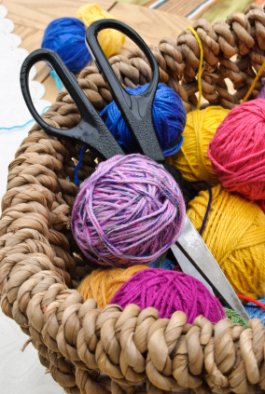10 Tips to Maintaining a Healthy Stash
10 Tips to Maintaining a Healthy Stash 
When it comes to stash management, creative crafters have developed as many ideas as there are yarn shades! A disorganized stash is difficult to use effectively, with leftovers from new projects added to existing oddments, which can quickly get out of hand. Once your stash is organised however, you can easily check your stash each time you plan a new project. It’s likely you’ll find at least a few balls in there you can use, which will save you money and avoid doubling up on things. As an added benefit, each time you manage to use part of your stash you’ll get to feel like a superhero, and I’m sure your family will appreciate it too!
Managing your stash is a very personal thing, so there’s no such thing as a ‘Definitive Guide’, but the tips below may help you get the most from your stash or help spark your own ideas on how to make it best work for you.
-
Make your stash look appealing: use storage that inspires you. Finding containers that are a pleasure to handle and view will make it more likely you'll want to use what's inside them once you’ve got everything organised. Knitting and crochet are creative processes, so the more inspiration you can find the better. Plastic shopping bags are cheap and readily available, but a stash stuffed into bags tends to look and feel like it’s due for the waste, rather than full of beautiful, soft crafting materials just waiting to be converted into stunning projects. You don’t need to spend a tonne of money beautifying your stash: a trip to the local op shop can turn up all sorts of wonders if you don’t mind the eclectic look, or for a more uniform approach, discount stores are a great first port of call. Yarn can also make a gorgeous display: a ceramic or glass bowl or vase filled with yarn can make a lovely centrepiece (and you can use the yarn whenever you feel in need of a change).

- Generally speaking, when organising your stash, the first step is to rough sort your yarns by colour, ply or fibre, depending on the nature of your stash and what you most commonly use it for. I tend to use mine mostly for adding small amounts of contrast colour to garments or accessories, so I organize first by ply – I can then look through for a shade I like and know everything I see there will work with my pattern.
- A separate container for yarns you already have a project in mind for is a great option – you can bag up the yarn with a copy of the pattern if it’s a leaflet, or with a photocopy or details of the page number and book to find the pattern if the pattern’s part of a collection.
-
 For yarns you’ve fallen in love with but don’t yet have a specific project for, it’s a great idea to jot down details of the yarn in your diary or phone, including ply, number of balls, shade and type of project you feel it would be great for. That way, you’ll know what to look for next time you’re browsing through patterns. If you have a lot of ‘yarns without plans’ in your stash, keeping them all in the one place is helpful, so you can easily find them and transfer them to your ‘ready to go’ box as you find projects for them. You may also be inspired by the shade combinations you find in there, leading to creative flights of fancy which may otherwise escape you!
For yarns you’ve fallen in love with but don’t yet have a specific project for, it’s a great idea to jot down details of the yarn in your diary or phone, including ply, number of balls, shade and type of project you feel it would be great for. That way, you’ll know what to look for next time you’re browsing through patterns. If you have a lot of ‘yarns without plans’ in your stash, keeping them all in the one place is helpful, so you can easily find them and transfer them to your ‘ready to go’ box as you find projects for them. You may also be inspired by the shade combinations you find in there, leading to creative flights of fancy which may otherwise escape you! - Another option is to photograph your stash, and paste the pics into a program like One Note or Word (or any program that lets you save pictures with captions), or onto your Ravelry profile, with details of what the yarn is, the pattern you intend to use it for, where to find it in your stash and what additional yarn/needles you need before you can start work on it. Instead of pulling your stash out of the wardrobe every time you need to buy yarn, you can simply consult your "virtual" stash to find out what yarn, patterns and needles you need. Just beware: your virtual stash needs to stay organised too in order to be useful. If you use or move yarns without documenting the changes, you'll quickly get into trouble and find you're having to sift through your 'real' stash again to work out your shopping list.
-
Make sure you include ballbands with your part balls – you’ll never use the yarn again if you don’t know the tension and ply for it, and having the care instructions on hand will help avoid washing disasters down the track! The ballband will also help you track down extra balls if you get caught short.

- Tiny oddments (less than 5g) are great for embroidery trims etc. It’s probably more useful to keep all these very small bits together in a single bag rather than in with their ply or colour, as they're all to be used for trimming rather than knitting.
- Once you’re organized, consider the potential impact of pests on your stash. Moths and rodents can decimate your yarn, which can be very upsetting. If your stash is stored in a shed rather than indoors, you’ll need to take greater measures. An ounce of prevention is worth a pound of cure!
- If you find yarns in your stash you know you'll never use again: let them go. If it's in a ply that's uncommon and you can’t get patterns for it, it's a style of yarn that went out of fashion a long time ago but you held on to 'just in case', or you didn't enjoy working with it the first time, it's time to show it the door. You don't have to throw it out: consider offering it to other crafters or donating it; just because it didn't suit you doesn't mean it won't find some love elsewhere. Daycares/kinders and schools enjoy these materials for craft activities and more – they’ll love you for it and you’ll feel warm and fuzzy for days afterwards :)
- Decide how large you want your stash to be, and stick to it. If you want it to fit inside one crate/on one shelf/inside one cupboard, then you'll need to have a cull each time you add to your stash. Don't just keep cramming it in there! (Please note: this is a case of "do as I say, not as I do.”)
I hope you’ve found these tips useful, and they inspire you to make your stash work better for you. Pulling out your whole stash and sifting through it all can be a huge amount of fun if you go into it with an attitude of curiosity and discovery, and you’re bound to find some treasures which would not otherwise see the light of day again. Happy Sorting!
